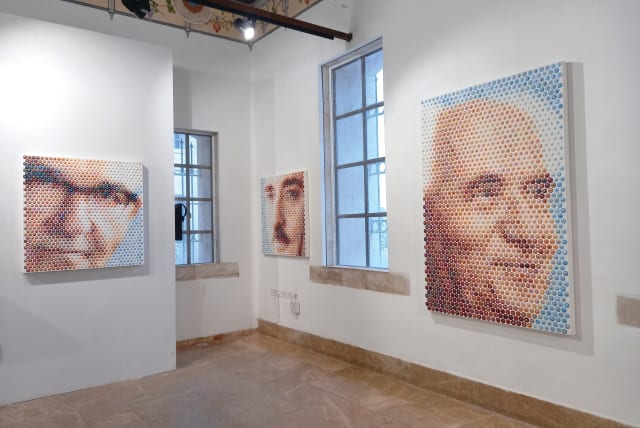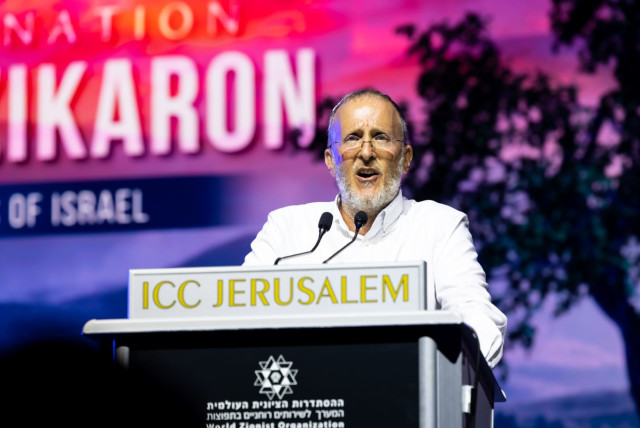My Word: Life, art and political perspective

Not only art students need to learn to step back to connect the dots. It’s an art we should all appreciate.
Sometimes you have to step back to get the full picture. This is the message behind the “Prime Ministers in Perspective” exhibition that was briefly held at the Jerusalem Biennale Gallery, in the Old Shaare Zedek building on Jaffa Road.
The walls of the beautiful former hospital were decorated with 12 portraits of Israeli premiers – from David Ben-Gurion to Benjamin Netanyahu – in the distinctive neo-pointillist style of South African artist Gavin Rain, showing his combined love of art and mathematics. Each portrait is composed of approximately 1,000 multi-layered and multi-colored concentric circles on a white canvas. The full image can only be appreciated when the viewer looks at the works from a distance.
“Art is about creating a visual narrative” noted Rain in the written explanation accompanying the exhibition. “It is a metaphor for life – we should all step back to see the bigger picture, the people that help, guide and shape us.”
The collection, which was commissioned by Myron Zaidel in 2019 in advance of his aliyah from South Africa, took a year to complete.
“The art form itself was appealing to me,” Zaidel said. “You can look at the picture many ways and if you look at it the right way, you see the full picture.”
At the festive opening, Zaidel quipped “I think it’s the first time all 12 prime ministers are together in one room.”
Given the current political turmoil – and the historic rivalries among the country’s leaders – that should be seen as something positive. But never underestimate social media’s ability to give a distorted picture. Jerusalem Biennale founder and curator Rami Ozeri noted that when he tried to promote the exhibition on Facebook, the sponsored ad was blocked, apparently because the artworks were presumed to carry a political message. Meta’s algorithms couldn’t separate life from art.
Zaidel hopes that the collection will be shown abroad in the future, before eventually being donated to an Israeli institution for permanent display. It certainly offers a different way of looking at things.
The exhibition was held in honor of Israel’s 75th anniversary celebrations last month, but I got caught up in other events, including the mammoth rocket attacks from Gaza and Operation Shield and Arrow, and didn’t get a chance to step back and write about what I had seen and learned.
A look around the exhibit hall was a reminder that almost all the country’s leaders had to deal with issues of war and peace and the struggle for international acceptance.
Some of the prime ministers are better known than others in the wider world. But my eyes lingered on the colorful dots that created the face of Levi Eshkol, under-appreciated as a visionary who helped shape the early state. Responsible, among other things, for establishing the National Water Carrier and Mekorot, Eshkol is quoted as having said: “Water is the blood in our veins.” Talk about understanding the greater picture.
The half smile in Eshkol’s portrait is backed by his ironic humor. “Put three Zionists in a room, and they will form four political parties,” he once joked. My favorite Eshkol quote is: “I compromise and compromise and compromise... until I get my way.”
Eshkol was the prime minister who managed to get the country through the Six Day War in June 1967, avoiding the predicted mass civilian casualties, reuniting Jerusalem and the Etzion Bloc and bringing the Golan Heights and Gaza under Israeli control, yet few associate his name with this stunning success. Even studying his picture from a slight distance, I had to admit that Eshkol lacked the charisma and charm that granted an advantage to his younger Sabra rivals, Moshe Dayan and Yitzhak Rabin.
Golda Meir, the only female face in the exhibition of Israeli premiers, is still making a name for herself in the ratings war. Golda, a new movie starring Helen Mirren, is due to go on general release in August.
During the latest round of Hamas hostilities, I read several versions of the comment: If women ruled the world, there would be no more wars. Looking at the historical picture, I have a different perception. It would take more than women breaking the political glass ceiling en masse to achieve world peace. Golda, Margaret Thatcher and Indira Gandhi, for example, were each prime ministers of countries where war broke out on their watch.
There’s an art to joining the dots in one of Gavin Rain’s portraits. Although the exhibition in Jerusalem ended shortly after Independence Day, the pictures – and the message – continue to hang around in my mind.
Gain perspective: The need in Israel to step back
The need to step back, to see things in perspective, and to connect the smaller circles is as necessary in political science as it is in the pointillist art form.
Every individual circle and dot has the ability to change the overall appearance – to improve it or ruin it: To make it picture perfect or turn it into a bad image.
Several examples of shortsightedness come to mind within the last couple of weeks. There is not only one way to look at things.
“What would any other country do if more than 1,000 rockets were launched on it,” a friend asked on Facebook during Operation Shield and Arrow. It was meant to be a rhetorical question but I couldn’t resist shooting back: “They’d blame Israel, of course!”
CNN’s Christiane Amanpour blamed the victims when she said of the murdered members of the Dee family: “They were killed in a shootout.” There is something seriously wrong with the picture that Amanpour painted.
She implied that the unarmed Lucy Dee and her young daughters, Maia and Rina, were somehow equally to blame for their own deaths, when in fact, they were murdered on Passover by Palestinian terrorists who opened fire on their car as they were driving in the Jordan Valley at the start of a family vacation.
After a public outcry, led by Honest Reporting among others, Amanpour on Monday apologized saying that during “a live interview, I misspoke and said that they were killed in a ‘shootout’ instead of a ‘shooting.’” She noted that she had also apologized to Rabbi Leo Dee, the widower and bereaved father.
Israeli TV anchor and model Galit Gutman also issued an apology after shooting her mouth off on live television last Friday. “How much of a burden can be placed on a third of this country to keep all these ultra-Orthodox people who suck our blood?” Gutman said on a Channel 12 show while talking about the anti-government protest held in Bnei Brak. After a backlash accusing her of, in effect, promoting antisemitic tropes and a blood libel against the haredim, Gutman tried to explain: “The words were said during a discussion on the government budget and the property tax fund,” adding: “But I have no intention of offending anyone.”
Zooming out, it is obvious that the leaders of the anti-government protests have moved the focus from the judicial reform to the role of the ultra-Orthodox in Israeli society. (Some protesters mistakenly see the entire haredi sector as a monolithic body, rather than separate communities, ignoring the different elements in the larger picture.) Marching on Bnei Brak is itself a provocation aimed at creating a certain picture in the media.
For more ultra-Orthodox to serve in the IDF, conditions would have to change and the High Court would need to permit the necessary laws and regulations. Currently, there is an inverse Catch-22 paradox in which many young haredim are neither able to serve nor enter the workforce.
Incidentally, IDF figures released at the end of last year show that the national induction rate for Jewish males in 2022 was 69%. Approximately 16% of the induction-age Jewish population were exempted to pursue yeshiva studies while 15% received exemptions for other reasons. When you look at it this way, there was not a huge difference in the numbers receiving an exemption.
Similarly, while the budget debate this week hinged around the huge sums demanded by the haredi parties for yeshivas and religious studies, university staff went on strike over a salary dispute, whose benefit to the average student is tangential at best.
Not only art students need to learn to step back to connect the dots. It’s an art we should all appreciate.
liat@jpost.com
Jerusalem Post Store
`; document.getElementById("linkPremium").innerHTML = cont; var divWithLink = document.getElementById("premium-link"); if (divWithLink !== null && divWithLink !== 'undefined') { divWithLink.style.border = "solid 1px #cb0f3e"; divWithLink.style.textAlign = "center"; divWithLink.style.marginBottom = "15px"; divWithLink.style.marginTop = "15px"; divWithLink.style.width = "100%"; divWithLink.style.backgroundColor = "#122952"; divWithLink.style.color = "#ffffff"; divWithLink.style.lineHeight = "1.5"; } } (function (v, i) { });

